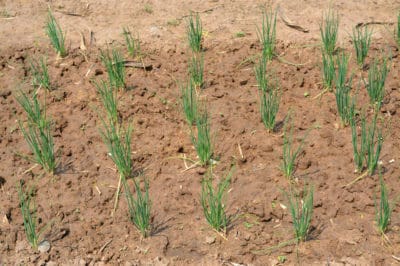When to Plant Different Types of Shallots
If you have stored shallots that are showing signs of breaking their dormancy in the fall, you should plant them rather than lose them. Other than that, there are three main types of shallots that have seasonal preferences for planting.
- Gray shallots – fall planting is recommended because these shallots frequently break dormancy in the fall
- Red shallots – spring planting is recommended because these shallots are in a deep state of dormancy in the fall, especially if they were grown from seed.
- Gold shallots – spring planting is recommended because these shallots are in a deep state of dormancy in the fall, especially if they were grown from seed.
Sowing Shallots From Seeds
If you want to try growing shallots from seed, you will need to sow your seeds in late winter and keep them indoors under grow lights or a cool white fluorescent light. Plant them early enough that you have time to harden them and transplant them four to six weeks before the last frost date in your area.
Hardening Your Shallot Seedlings
You should begin hardening your seedlings one to two weeks before you intend to transplant them. They should have developed four to six leaves.
Choose a cloudy afternoon, water your seedlings, and move them outdoors to a sheltered area such as a cold frame, a box, or a crate for two hours. The next day, set your shallots out for around four hours allowing them an hour of sunlight in the morning. Each day, lengthen the amount of time you leave your shallots outdoors, and the amount of time you leave them in the morning sun. You can eventually leave your shallot seedlings out overnight as long as there won’t be a heavy frost.
Transplanting Your Shallots
When transplanting your shallots, create furrows that are 6 inches deep and 1 foot apart for each row. Line the bottom of the furrow with a balanced organic fertilizer and replace half of the soil. Space your shallots 6 to 8 inches apart and cover them with the remaining soil. Because shallots grow in clusters, they take up more room than garlic or green onions. Planting them too close together will result in fewer and smaller bulbs.
Sowing Shallots from Sets
You can sow shallot sets in the spring or the fall.
Sowing Sets in the Fall
If you are planting your shallot sets in the fall, you should plant them in October, or at least make sure that you have them planted before the first freeze. Work the soil thoroughly, and then dig small, shallow holes 6 inches apart that are just a little larger than the set. The rows should be at least 12 inches apart. Place compost or a balanced organic fertilizer in the bottom of the hole, cover it with dirt, and then place the set in the hole with the wide end, the basal plate, down and the pointed end up, Cover the set so that just a little of the tip shows, and then cover all of the shallots with 6 inches of leaves.
Sowing Sets in the Spring
If you intend to plant your shallots in the spring, you should work the soil in the fall and cover it with leaves. In the spring, plant your shallots four to six weeks before the last frost date for your area. They will need about four weeks of weather with temperatures between 32°F and 50°F (0°C and 10°C) to encourage sprouting. Plant and space the shallots as described above for fall planting.
EAR
